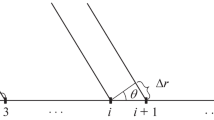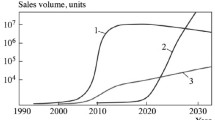Abstract
The paper studies the dependence of the potential noise immunity of a detection system and noise immunity of a detection system with an interference compensator on the array parameters, angular signal position and local noise, the degree of correlation of distributed noise and spectral densities of the signal power, noise, and interference. The gain in noise immunity of the detection system when the optimal spatial filter is used with respect to the use of an interference compensator is estimated as a function of the degree of correlation of distributed noise and the power of random amplitude–phase errors of the weight coefficients of the array.
Similar content being viewed by others
References
A. G. Sazontov and A. I. Malekhanov, Acoust. Phys. 61 (2), 213 (2015).
G. S. Malyshkin and G. B. Sidel’nikov, Acoust. Phys. 60 (5), 570 (2014).
V. C. Anderson, J. Acoust. Soc. Am. 45 (2), 398 (1969).
Ya. D. Shirman and V. N. Manzhos, Theory and Technique for Processing Radar Information on Noise Background (Radio i Svyaz’, Moscow, 1981) [in Russian].
V. G. Gusev, Systems for Spatiotemporal Processing Hydro-Acoustic Information (Sudostroenie, Leningrad, 1988) [in Russian].
G. S. Malyshkin, Optimal and Adaptive Methods for Processing Hydro-Acoustic Signals, Vol. 2: Adaptive Methods (The State Research Center of the Russian Federation–Concern CSRI Elektropribor, JSC, St. Petersburg, 2011) [in Russian].
V. A. Zverev, Acoust. Phys. 62 (3), 383 (2016).
J. Capon, Proc. IEEE 57, 1408 (1969).
J. Li, P. Stoica, and Z. Wang, IEEE Trans. Signal Process. 52, 2407 (2004).
Y. Wang, J. Li, and P. Stoica, IEEE Trans. Signal Process. 53, 2713 (2005).
W. J. Bangs and P. M. Schultheiss, in Signal Processing (Academic Press, London, 1973), pp. 577–590.
E. N. Kalenov, Acoust. Phys. 61 (2), 205 (2015).
G. M. Jenkins and D. G. Watts, Spectral Analysis and its Applications (Holden-Day, San Francisco, 1968).
W. S. Burdic, Underwater Acoustic System Analysis (Prentice-Hall, Englewood Cliffs, NJ, 1984).
V. I. Mayatskii, Radiotekh. Elektron. 12 (12), 2118 (1967).
M. D. Smaryshev, Directivity of Hydro-Acoustic Antennas (Sudostroenie, Leningrad, 1973) [in Russian].
Author information
Authors and Affiliations
Corresponding author
Additional information
Original Russian Text © E.N. Kalenov, 2018, published in Akusticheskii Zhurnal, 2018, Vol. 64, No. 3, pp. 379–388.
Rights and permissions
About this article
Cite this article
Kalenov, E.N. Immunity of a Detection System for Optimum Space Filtration and Use of an Interference Compensator. Acoust. Phys. 64, 365–374 (2018). https://doi.org/10.1134/S1063771018030089
Received:
Published:
Issue Date:
DOI: https://doi.org/10.1134/S1063771018030089




